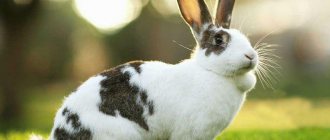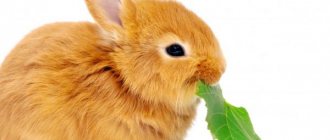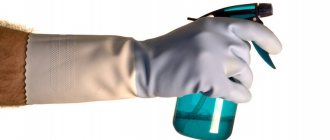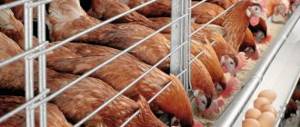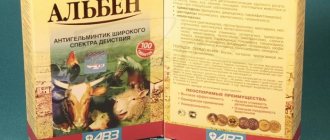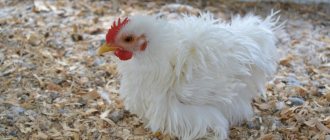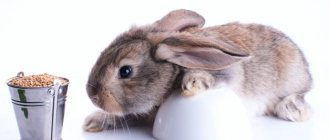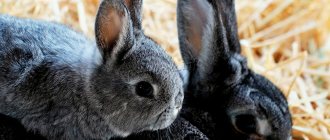Is it dangerous to give radishes to rabbits?
Radishes are one of the first vegetables to ripen in the garden beds in the spring. It has a bitter taste and helps replenish the lack of vitamins after winter. Farmers who have their own gardens are interested in whether it is possible to give radishes to rabbits. This article will tell you whether brightly colored vegetables and their tops are harmful to long-eared pets.
Radish for rabbit
Is it possible to give a rabbit grass?
Green food is another type of food that can be given to rabbits. This includes cultivated grasses, grass, beans, cereals, leaves of root crops and tubers. From mid-spring to mid-autumn - this is the basis of any rabbit’s nutrition and an essential component. From green food, rabbits can:
- vetch;
- lawn grass;
- fodder beet tops;
- turnip greens;
- fodder clover;
- alfalfa;
- sweet lupine;
- green oats, rye, barley (young);
- fodder corn greens.
Important!
You can only feed your rabbits clean grass that has not been sprayed with chemicals. Give only dried grass. Giving freshly cut grass with race to rabbits is strictly prohibited.
Grass crops are very important for rabbits, but they must be given with caution. The abundance of such food can lead to flatulence, but that’s not all. It is not recommended to feed rabbits plain grass growing near the road or in the field. To begin with, poisonous grass can also get into the bunch; in addition, the grass near the road is poisoned by exhaust gases.
Feeding green food is very simple. You need to collect it, spread it on a flat surface so that it wilts a little for 4-5 days, and only then give it to the animals.
Radish composition and beneficial properties
A relative of the radish, the radish has a rich chemical composition. Vitamins found in it:
- thiamine;
- pyridoxine;
- folic acid;
- RR;
- TO;
- ascorbic acid.
Folic acid is necessary for the proper development of embryos, so radishes are useful for pregnant rabbits. Vitamin C strengthens the immunity of animals. Pyridoxine and thiamine are substances necessary to ensure the normal functioning of the nervous and digestive systems of rodents.
By eating radishes, the rabbits' body is enriched with micro- and macroelements - iron, phosphorus, calcium, magnesium, etc. By receiving the full range of useful substances, the animals get sick less, and the quality of their fur and the taste of the meat improve.
Attention! Radishes contain essential oil, which gives the vegetable bitterness, and a lot of coarse dietary fiber. These substances irritate the intestinal mucosa of rodents, so vegetables are given to animals in limited quantities.
Can a rabbit eat bread?
We recommend reading our other articles
- The best varieties of white grapes
- How to properly prepare bees for wintering
- Raspberry variety Patricia
- The best early grape varieties
Considering that bread is made from grains that are healthy for rabbits, many people wonder whether it is possible to give bread to rabbits or replace them with concentrated food. No! Bread and any baked goods do not provide any nutritional value to a rabbit as they do to humans. Therefore, under no circumstances should you give it or, especially, replace concentrates with it!
Important!
Baked goods usually contain sugar. This is the enemy of any rodent, so it is prohibited for rabbits.
In addition to the fact that bread is not beneficial for long-eared animals, it also harms them. The animal may begin to gain weight, its teeth may fall out or simply deteriorate, and it may begin to refuse other food. All this will lead to disruption of the functioning of organs, systems and many other consequences.
Radishes in a rabbit's diet
You can feed rabbits radishes starting from 2-2.5 months. Before distributing it to the rabbits, it is washed and cut into pieces. Adult pets can be given the whole fruit 2-3 times a week. The serving size for a pet should not exceed 80 grams. If after eating radishes the animal’s stool becomes liquid, it is excluded from the menu.
You can give your rabbits radish tops; they also contain many useful substances. The green part of the culture does not irritate the stomach and intestines. It is recommended to wash freshly harvested tops with water to remove dust and dry them for 3-4 hours in the shade. After this, it is distributed to pets along with other greens from the garden.
Attention! Radish tops can be ensiled and dried for the winter, including in hay.
You can feed tops to baby rabbits starting from one and a half months of age, if they react normally to the new product.
Some rabbits do not like radishes because of their bitter taste, but will happily eat the tops. In this case, there is no need to offer the vegetable. Uneaten food scraps should be removed from the cage, otherwise they will begin to rot. The farmer should remember that the health of rodents depends on how varied their diet is.
What vegetables can you give rabbits?
It is known that the main food of animals is hay, but it needs to be supplemented with fresh vegetables and fruits. Juicy food is a source of vitamins and minerals, an opportunity to pamper your pet with a tasty berry. Vegetables are added to the food gradually and carefully, even those collected at the dacha are not always beneficial for the rabbit.
The delicate organism of animals can react violently with unpleasant moments, for example:
- stool disorder;
- swelling;
- intestinal obstruction;
- accumulation of gases.
After carefully observing the decorative rabbit, it is important to determine which vegetables are preferred. But you should not constantly offer one root vegetable or greens; the eared fish needs to create variety. The following vegetables are essential in the diet:
- green peas;
- cabbage (some types);
- potatoes (tubers only);
- beet;
- lettuce leaves (preferably dark varieties);
- carrots (root and tops);
- zucchini (pumpkin);
- cucumbers;
- radish.
Green peas . The fruits are rich in proteins, lysine, and are easy to digest. Rabbits quickly gain weight, but to prevent gases from bothering the animal, it is better to mix peas with bran and mixed feed.
Cabbage . Rabbits' favorite vegetable, but with a lot of reservations. Of course, so juicy, up to 90% water, a lot of vitamins E and C. Vitamins make the fur silky, pleasing with a healthy shine. Although animals will happily eat any cabbage, experts advise caution when feeding cauliflower, savoy and broccoli leaves. In white cabbage, only the top leaves are used, of which you need a little so as not to provoke bloating.
Potato . Very little is used. Potatoes contain a lot of starch, which stimulates weight gain. Therefore, boiled tubers are given no more than once a week. Excellent nutrition for meat breeds, but for decorative breeds there are restrictions.
Beet . Fodder beet fits perfectly into the diet of long-eared animals. Especially the sugar variety - it is offered boiled and raw. The tops are rich in microelements, but due to their laxative properties they are given in combination with oak and alder branches, which have an astringent effect.
See also
Symptoms and diagnosis of lichen in rabbits, treatment and preventionRead
Lettuce leaves . The composition contains oxalic acid, which causes kidney failure. But the salad also contains quite a lot of vitamins and beneficial microelements. Choose dark lettuce varieties due to their low calcium content.
Carrot . A storehouse of carotene. Only small root vegetables are used for food in raw form, whole or in pieces. To ensure regular consumption, alternate with dried carrot greens.
Zucchini, pumpkin . Only fresh pieces increase the digestibility of hay. Zucchini spoils quickly and can cause diarrhea in the animal. Pumpkin improves digestion, which immediately affects the quality of the coat. The seeds are suitable for preventing worms. You can make pumpkin puree for kids.
Cucumbers . A low-calorie vegetable that is indispensable for summer nutrition, added grated or chopped to other foods. Useful for rabbits because it promotes lactation.
Radish . Contains folic acid and a lot of useful substances. During the season they give without restrictions. It is better to mix the tops with other greens.
Corn (raw milk, boiled) will also be useful for the rabbit. And do not forget about a sense of proportion. Another vegetable that can become a favorite delicacy is Jerusalem artichoke, a piggy bank of all sorts of useful things. Having tasted it raw, long-eared animals often refuse other food.
Table of vitamins contained in vegetables recommended for food:
| Vitamins | ||
| Vitamin A | Vitamin C | Vitamin B |
| carrots and tops, lettuce, broccoli, cauliflower, parsley | rutabaga, carrot tops, Brussels sprouts, broccoli, radish tops, parsnip root, Jerusalem artichoke | broccoli, Brussels sprouts, cauliflower, carrot tops, radish tops |
Benefits and harms
Radishes have a rich chemical composition and especially beneficial vitamins and minerals that have a positive effect on growth.
The following article will tell you more about the vitamins that are essential for the development of rabbits.
Thus, radishes have the following properties:
- vitamin B affects the nervous system of rabbits;
- vitamin C prevents colds, which most often affect rodents;
- phytoncides are natural antibiotics that disinfect the body;
- fiber restores the digestive system;
- antioxidants accelerate metabolism, regenerate cells, and have a positive effect on wool quality;
- phosphorus, magnesium, potassium and other minerals strengthen the circulatory, nervous system, and heart;
- pectin removes harmful substances, stones, bile, strengthens the skeletal system;
- metabolism and blood circulation accelerates;
- blood thins, fats are broken down;
- the immune system is strengthened.
The vegetable contains essential oils, coarse dietary fiber and bitterness, which lead to irritation of the intestinal mucous membranes if consumed in excess. Therefore, radishes are given to eared cats in limited quantities.
Use of vitamin and mineral supplements during feeding
If the menu is made up of simple and natural products (grains, herbs, vegetables), you cannot do without additional vitamins and minerals. As a mineral supplement for strong bones and teeth, you can give chalk to rabbits by adding it directly to the grain mixture. Instead, they use pieces of limestone, which are simply placed in the cage. Animals are also offered the following as a source of minerals:
- pieces of charcoal;
- clay or expanded clay;
- turf cut from a field.
A mandatory component of the daily menu is table salt. The daily norm is 3–5 g per animal. Excess salt can lead to pet poisoning.
In winter, it is useful to give animals complex vitamins . Water-soluble compounds are used ( Chiktonik, Tetrahydrovit), which are added to drinking water. The course of supplementation with vitamins is 3–6 days, monthly.
Chiktonik
Tetrahydrovit
How to properly feed radishes to rabbits?
There are rules for feeding rabbits with radishes that must be strictly followed:
- You can introduce vegetables into your diet starting from a month, but it is better from 2 months.
- Initially, radishes are cut into small pieces, but once the rabbit reaches 3 months, they are allowed to be given whole.
- Before serving the “dish,” the vegetable is washed under running water to keep it clean.
- You can only give well-ripened root vegetables, without rot or mold.
- It is permissible to feed your pets radishes no more than 3 times a week.
- If you notice that your rabbits' stool has become liquid, you will have to temporarily give up the vegetable and then reduce the dosage.
- If there are remnants of radishes left in the feeders, be sure to remove them, as the vegetable will rot, which will harm the health of the rodents.
- The daily serving volume is a maximum of 80 grams.
Is it possible to give dandelions to rabbits?
Dandelions are not just a tasty plant for rabbits, but more of a treat that can be given in moderation. Usually all types of rabbits love dandelions and eat them with great appetite. You can feed both the green leaves and the stems on which the flower rests, but it is better to remove the flower itself.
Before serving, you should thoroughly wash the culture and dry it a little. This tasty addition to the diet will make any rabbit happy!
Dandelions are a treat for rabbits
Can rabbits be given radish tops?
The tops, like the root vegetable itself, have a rich composition and many beneficial properties. It is soft and tender, so rabbits eat it with pleasure. Moreover, it is recommended to harvest the tops for the winter, drying them in natural conditions, and then ensiling them along with hay. Can be prepared according to the following recipe:
- Fresh tops are mixed with the top part of vegetables such as carrots, potatoes, Jerusalem artichoke, and cabbage.
- Place tightly in a glass jar, closing with a regular lid.
- The mixture is left to ferment for several days, due to which lactic acid is released.
- When this happens, you can give it to the ears.
It is advisable to use tops from your own garden to be sure of their safety. Before giving to the rabbits, wash the greens and dry them a little in the shade (3 hours is enough). It is allowed to introduce rabbits into the diet from one and a half months.
There is a list of succulent foods that can be given to rabbits
Succulent foods include fruits, some vegetables, and plant tops. Let's try to figure out which type of food is more suitable for pets and which is better not to give.
Vegetable tops
Is it possible to give carrot tops to rabbits? Definitely, this is a very good food for animals. The tops are in no way inferior to the roots, but are easier to pickle and have more fiber. It is also rich in carotene, vitamins and other nutrients that animals need. Young animals also eat carrot tops with pleasure; they are as necessary for them as the roots, as they are a source of many vitamins.
Do rabbits eat carrots? Here the answer is also clear: they eat it with pleasure at any age, but the vegetable should not become the main food. Excess carotene and vitamin A can harm the animal. It is better to give him carrots no more than once a day, or even every other day.
Pea tops
What other tops are suitable for a rabbit? Are pea tops allowed for animals? Animals respond well to legumes. You need to be careful with babies so that their tummy does not swell.
They also ask whether to feed rabbits with radish tops. The answer is not so clear-cut, because some livestock breeders say that adding a little of this feed to the diet will not hurt, while others deny this. In any case, radish tops are not very useful for animals, as they may develop intestinal problems. If radish tops do get into the cage, you should not panic. In small quantities it will not harm.
Can rabbits have radishes or not? The answer is yes. You can give radishes without fear, but not those that have just been picked from the garden. The vegetable should dry out a little. For kids you can finely chop the radishes, for larger animals you can give them whole. Radishes should not be given to rabbits often.
Many people still ask, is it possible to introduce turnips into the food of rabbits? The attitude towards it should be approximately the same as the attitude towards radishes. Turnip root is a completely suitable food, but the tops should be given with caution.
Is it allowed to give tomato tops to rabbits? There is not even a discussion here, since tomato tops are poisonous and cannot be used as animal feed. The substances it contains have a negative effect on the nervous system. The same applies to sweet pepper tops and, by and large, potatoes too, although some people give potato tops to their pets in small quantities. Still, it’s better not to take risks.
Tomatoes
So, we've sorted out the tops, but how will rabbits react if they are given tomatoes? These fruits also have a lot of useful properties. Its fruits are as harmful as tops, and in small quantities they are used as feed. You need to get used to eating vegetables gradually: give a sixth or a fourth of the fruit once a day until you reach half. Giving tomatoes is allowed only once a day, preferably in the morning.
Strawberry
Interesting question, can rabbits eat strawberries? Strawberries are quite suitable as a treat or fruit bait. It should be fresh, without the slightest sign of rot. It should be given to older animals that are already three months old. Strawberries are healthy because they contain a lot of vitamins, microelements, and glucose. In addition to fruits, stems are also suitable as food, but you shouldn’t pamper animals with such a delicacy too often. It is best to treat them to strawberries once or twice a week, and feed them the stems no more than every other day.
Bananas
Bananas
Are bananas included in the diet of rabbits? The pleasure of feeding such fruits is expensive, and it is possible to do this only when the animal is alone in the house. It is better to give not the pulp, but the skins as a treat. But when asked whether rabbits can have rhubarb, they answer more positively. This plant in early spring can become an invaluable source of vitamins for animals. It grows well in any garden. In the spring, when green and succulent food is scarce, rhubarb can replace many of them. Are raspberries added to rabbits' diet? Of course, they add berries and twigs. Raspberries are very useful, especially the pagons of the plant in winter.
Snot juicy
What other kind of juicy food can you give to rabbits? People often ask whether to give fresh cucumbers to rabbits or not. This vegetable is useful for animals, especially since with a good harvest this feeding is quite inexpensive, and animals eat cucumbers with great appetite. Cucumbers must be fresh, without rot or mold, so that the animals do not get sick.
Also, rabbit breeders often ask whether Jerusalem artichoke is allowed for rabbits. The vegetable is very useful not only for people, but also for animals. Jerusalem artichoke is very useful for animals in winter, when they have enough green food and vitamins. It is stored for a long time, so you can make considerable reserves.
Jerusalem artichoke is very useful for pregnant and lactating females, as well as animals during the mating period. Jerusalem artichoke is given to young animals from three months. Is it possible to add salad to rabbit food? The animal will also really like this greenery, and it can be given with the same frequency and in the same percentage as other succulent foods. Salad is sometimes given instead of grass, but only when there is a lack of it. It is advisable to feed salad in the first half of the day.
Juicy food should not make up more than a third of the diet. Small animals are given this type of food only after three months. All succulent food must be in good condition, free from rot and fungi.
Can rabbits have radish tops?
In the wild, rabbits eat greens, using a variety of annual and perennial grasses. When kept indoors, they should also have plenty of greens in their diet. Only under this condition will they receive a sufficient amount of vitamins for health.
It is not recommended to feed freshly picked plants
When choosing fresh greens for their food, it is not recommended to give them freshly picked plants. It is better to keep them for at least a day before eating.
They actively eat a variety of plants:
Note! For the winter, it is customary to prepare greens, which need to be chopped and preserved for preservation.
Among other types of greens, rabbits can eat radishes and their tops.
How to water rabbits
Clean fresh water should be in the drinking bowl at all times. It is convenient to use vacuum automatic drinkers, as they do not become dirty.
On average, a rabbit drinks about 1 liter of water per day. When feeding dry food (hay, mixed feed), the animals' need for water increases, and when feeding succulent food, it decreases.
A balanced diet has a positive effect on the health of the livestock. It is important to take into account the seasonality of food and make winter supplies in a timely manner so that animals receive the necessary substances during the cold season. Farmers adjust the diet of rabbits depending on their age and condition.
Benefits and harms
This plant is rich in nutrients and vitamins. Eating it in moderation can ensure that there are no harmful effects on your rabbit.
Radishes contain the following beneficial substances:
- vitamins PP and K;
- folic acid;
- pyridoxine;
- thiamine;
- ascorbic acid.
Note! Folic acid is a substance that is especially beneficial for pregnant rabbits.
The fact is that this substance is exceptionally useful for the development of the embryo. Ascorbic acid has properties that enhance the immunity of these animals. Pyridoxine and thiamine have an important influence on the proper functioning of the digestive and nervous systems.
This product contains not only vitamins, but also useful substances and minerals. These include phosphorus, iron, calcium, magnesium and others. Good nutrition not only has a positive effect on the health of fluffies, but also makes them more productive, improves the taste of meat, and makes their coat more beautiful.
Despite the presence of useful substances in the composition, this plant contains essential oil, which gives the roots bitterness. In addition, it can cause indigestion in some cases.
Silage can be made from such greens to feed animals during the winter. Silage is made by preparing it from several components. To do this you need to do the following:
The presence of useful substances in the composition
- You will need to mix the greens of various plants. Among them you can take not only radish tops, but also carrots. Stems of Jerusalem artichoke, corn and sunflower, as well as cabbage leaves are added there.
- Everything that has been prepared must be thoroughly chopped. You need to cut it very finely and fill jars with the mixture so that mold cannot bloom.
- Next, you need to leave the prepared mixture for some time. As a result of fermentation processes, this composition is enriched with lactic acid.
The resulting silage mass will be a valuable product for feeding pets.
Note! It is important to use fresh food for animals. If the radishes are wilted or spoiled, there is no need to include them in the diet for rabbits. This is not the way to find out if rabbits eat radishes.
Harvesting beet tops for future use
In dry tops, the laxative effect is reduced, and vitamins and nutrients are preserved. Adding dried leaves of the red root vegetable to food is very useful.
They must be prepared in compliance with the following rules: cut the rosette from the fruit without detaching the leaves, then tie it up and hang it in a ventilated, dry room.
Attention! Dry tops can be stored in plastic lattice boxes, creating a shelving structure.
At what age can you
If the rabbit has not yet reached thirty days of age, then it is undesirable to feed it radishes or greens, which include their tops.
Important! It is believed that the smallest rabbit should not be given radishes and tops from them. Their stomach at this time is not yet able to absorb them sufficiently.
Starting from thirty days of age, animals can begin to be given radish fruit. In this case, the answer to the question of whether rabbits can eat radishes is positive. In this case, you need to grind it thoroughly. They can be given radishes treated in this way up to three months of age. Rabbits that are older than two or three months can be given radishes without restrictions.
The product must be washed thoroughly before adding to rabbit food. In this case, it is better to give crushed radishes to animals.
Tops can be given to these animals at almost any age. For the smallest rabbits, it is advisable to include it in the diet in limited quantities.
Note! It is best to give tops starting from one and a half months of age. At the same time, you need to monitor how well the fluffies tolerate this product.
What can you feed a decorative rabbit?
Note that, unlike dogs and cats, rabbits are herbivores and therefore their diet is significantly different. Even those that are suitable for guinea pigs and hamsters are not always beneficial for them. Let's figure out what decorative rabbits eat from natural food.
What should you feed rabbits?:
- Grass hay is a rich source of vitamins, protein, and fiber. Hay for decorative rabbits can serve as the basis of their diet all year round. Which one is better? Hay made from steppe forbs, nettles, and legumes and cereals is ideal.
- Green grass is what rabbits eat in the wild. Seeded herbs, wheatgrass, knotweed, dandelion, young burdock leaves, chicory, quinoa leaves, and clover are well suited.
- Garden greens are a good option; tops of carrots, radishes, turnips, turnips, as well as Brussels sprouts, strawberry leaves, Jerusalem artichoke, celery, basil, spinach, parsley, savoy cabbage, and various kinds of salads (except lettuce) are suitable.
- Vegetables are also included in the diet of these animals. What vegetables can you give rabbits? - Tomatoes, cucumbers and zucchini (after clearing them of seeds), turnips, carrots. But they should be given in moderation.
- Tree branches are not only nutritious, but also help to wear down teeth. Branches of linden, hazel, willow, ash, aspen, Canadian maple, pear, apple, acacia, and currant are suitable.
- Fruits - sometimes you can give apples, bananas, pears a little at a time.
Here is a list of everything you can feed a decorative rabbit from natural products. But today there are also ready-made factory-made feeds for rabbits, which will be discussed below.
Video: what to feed rabbits
Dry food for decorative rabbits
Nowadays, pet stores are full of ready-made food, including for rabbits. Factory-made feeds are positioned as complete, they contain all the substances necessary for the rabbit’s body (protein, vitamins, minerals, etc.). In principle, this is true, but not all dry food is equally good. Here are some popular manufacturers:
- Benelux (Belgium);
- Cliffi (Italy);
- Padovan (Italy);
- Jr Farm (Germany)
- Little One (Russia);
- Naturalist (Russia);
- Versele-Laga (Hungary/Belgium);
- Beaphar (Holland/Germany).
Most of these brands also produce food for other rodents, so be careful when taking food off the store shelf.
We also recommend that you study the composition of the food (indicated on the back of the package) before purchasing; it should not contain any products undesirable for rabbits.
Although it is true that a rabbit can only eat commercially prepared food, most nursery owners do not recommend this option. Ready-made food is best used as treats or when it is not possible to buy hay or other natural products.
Both regular and dwarf rabbits love greens.
